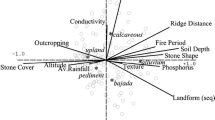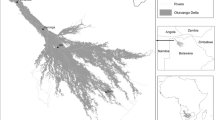Abstract
Riparian vegetation is distinct from adjacent upland terrestrial vegetation and its distribution is affected by various environmental controls operating at the longitudinal scale (along the river) or transverse scale (perpendicular to the river). Although several studies have shown how the relative importance of transverse or longitudinal influences varies with the scale of observation, few have examined how the influences of the two scales vary with the level of ecological organization. We modeled vegetation-environment relationships at three hierarchically nested levels of ecological organization: species, plant community, and vegetation type. Our hierarchically structured analyses differentiated the spatial extent of riparian zones from adjacent upland vegetation, the distribution of plant community types within the riparian zone, and the distribution of plant species within community types. Longitudinal gradients associated with climate and elevation exerted stronger effects at the species level than at the community level. Transverse gradients related to lateral surface water flux and groundwater availability distinguished riparian and upland vegetation types, although longitudinal gradients of variation better predicted species composition within either riparian or upland communities. We concur with other studies of riparian landscape ecology that the relative predictive power of environmental controls for modeling patterns of biodiversity is confounded with the spatial extent of the study area and sampling scheme. A hierarchical approach to spatial modeling of vegetation-environment relationships will yield substantial insights on riparian landscape patterns.






Similar content being viewed by others
References
Baker ME, Barnes BV (1998) Landscape ecosystem diversity of river floodplains in northwestern Lower Michigan, USA. Can J For Res 28:1405–1418
Bendix J (1994) Scale, direction, and pattern in riparian vegetation-environment relationships. Ann Assoc Am Geogr 84:652–665
Bendix J (1999) Stream power influence on Southern Californian riparian vegetation. J Veg Sci 10:243–252
Breiman L (2001) Random forests. Mach Learn 45:5–32
Caissie D (2006) The thermal regime of rivers: a review. Freshw Biol 51:1389–1406
Chambers JC, Tausch RJ, Korfmacher JL, Germanoski D, Miller JR, Jewett D (2004) Effects of geomorphic processes and hydrologic regimes on riparian vegetation. In: Chambers JC, Miller JR (eds) Great Basin riparian ecosystems: ecology, management and restoration. Island Press, Covelo, CA, pp 196–231
Cherrill AJ, McClean C, Watson P, Tucker K, Rushton SP, Sanderson R (1995) Predicting the distributions of plant species at the regional scale: a hierarchical matrix model. Landscape Ecol 10:197–207
Diez JM, Pulliam HR (2007) Hierarchical analysis of species distributions and abundance across environmental gradients. Ecology 88:3144–3152
Dufrène M, Legendre P (1997) Species assemblages and indicator species: the need for a flexible asymmetrical approach. Ecol Monogr 67:345–366
Ferrier S, Guisan A (2006) Spatial modelling of biodiversity at the community level. J Appl Ecol 43:393–404
Fisher SG, Grimm NB, Marti E, Gomez R (1998) Hierarchy, spatial configuration, and nutrient cycling in a desert stream. Aust J Ecol 23:41–52
Forbis TA, Provencher L, Turner L, Medlyn G, Thompson J, Jones G (2007) A method for landscape-scale vegetation assessment: application to Great Basin rangeland ecosystems. Rangel Ecol Manag 60:209–217
Franklin J (1995) Predictive vegetation mapping: geographic modelling of biospatial patterns in relation to environmental gradients. Prog Phys Geogr 19:474–499
Franklin J, McCullough P, Gray C (2000) Terrain variables used for predictive mapping of vegetation communities in Southern California. In: Wilson J, Gallant J (eds) Terrain analysis: principles and applications. Wiley & Sons, New York, US, pp 331–353
Friedman JM, Auble GT, Andrews ED, Kittel G, Madole RF, Griffin ER, Allred TM (2006) Transverse and longitudinal variation in woody riparian vegetation along a montane river. West North Am Nat 66:79–91
Gregory SV, Swanson FJ, McKee WA, Cummins KW (1991) An ecosystem perspective of riparian zones. Bioscience 41:540–551
Guisan A, Zimmermann NE (2000) Predictive habitat distribution models in ecology. Ecol Model 135:147–186
Hill MO (1979) TWINSPAN: a FORTRAN program for arranging multivariate data in an ordered two-way table by classification of the individuals and attributes. Cornell University, Section of Ecology and Systematics, Ithaca, NY, US
Hill MO, Gauch HG (1980) Detrended correspondence analysis: an improved ordination technique. Plant Ecol 42:47–58
Junk JW, Bayley PB, Sparks RE (1989) The flood pulse concept in river floodplain systems. Canad Spec Publ Fish Aquat Sci 106:110–127
Landis JR, Koch GG (1977) The measurement of observer agreement for categorical data. Biometrics 33:159–174
Lyon J, Gross NM (2005) Patterns of plant diversity and plant-environmental relationships across three riparian corridors. For Ecol Manag 204:267–278
McCune B, Mefford MJ (1999) PC-ORD: multivariate analysis of ecological data; Version 4 for Windows; User’s Guide. MjM Software Design
Naiman RJ, Décamps H (1997) The ecology of interfaces: riparian zones. Annu Rev Ecol Syst 28:621–658
Oneal A, Rotenberry J (2008) Riparian plant composition in an urbanizing landscape in southern California, USA. Landscape Ecol 23:553–567
Peters J, Verhoest NEC, Samson R, Boeckx P, De Baets B (2008) Wetland vegetation distribution modelling for the identification of constraining environmental variables. Landscape Ecol 23:1049–1065
Poole GC (2002) Fluvial landscape ecology: addressing uniqueness within the river discontinuum. Freshw Biol 47:641–660
Reed PB (1988) National list of vascular plant species that occur in wetlands. US Fish and Wildlife Service, Washington, DC, USA. Biological report 88:24
Richardson DM, Holmes PM, Esler KJ, Galatowitsch SM, Stromberg JC, Kirkman SP, Pysek P, Hobbs RJ (2007) Riparian vegetation: degradation, alien plant invasions, and restoration prospects. Divers Distrib 13:126–139
Saab V (1999) Importance of spatial scale to habitat use by breeding birds in riparian forests: a hierarchical analysis. Ecol Appl 9:135–151
Sandercock PJ, Hooke JM (2010) Assessment of vegetation effects on hydraulics and of feedbacks on plant survival and zonation in ephemeral channels. Hydrol Process 24:695–713
Shafroth PB, Stromberg JC, Patten DT (2002) Riparian vegetation response to altered disturbance and stress regimes. Ecol Appl 12:107–123
Stromberg JC, Tiller R, Richter B (1996) Effects of groundwater decline on riparian vegetation of semiarid regions: The San Pedro, Arizona. Ecol Appl 6:113–131
Thorp JH, Thoms MC, Delong MD (2006) The riverine ecosystem synthesis: biocomplexity in river networks across space and time. River Res Appl 22:123–147
Turner MG, Gergel SE, Dixon MD, Miller JR, Woods K (2004) Distribution and abundance of trees in floodplain forests of the Wisconsin River: environmental influences at different scales. J Veg Sci 15:729–738
United States Fish Wildlife Service, prepared by Otis Bay Ecological Consultants (2009) Walker river biophysical assessment. Lahontan NHF Complex, Reno, NV
Urban D, Goslee S, Pierce K, Lookingbill T (2002) Extending community ecology to landscapes. Ecoscience 9:200–212
van Coller AL, Rogers KH, Heritage GL (2000) Riparian vegetation-environment relationships: complimentarity of gradients versus patch hierarchy approaches. J Veg Sci 11:337–350
Vannote RL, Minshall GW, Cummins KW, Sedell JR, Cushing CE (1980) The river continuum concept. Can J Fish Aquat Sci 37:130–137
Ward JV, Florian M, Klement T (2002) Landscape ecology: a framework for integrating pattern and process in river corridors. Landscape Ecol 17:35–45
Webster JR, Meyer JL (1997) Organic matter budgets for streams: a synthesis. J N Am Benthol Soc 16:141–161
Wiens J (2002) Riverine landscapes: taking landscape ecology into the water. Freshw Biol 47:501–515
Wolock DM, McCabe-Jr GJ (1995) Comparison of single and multiple flow direction algorithms for computing topographic parameters in TOPMODEL. Water Resour Res 31:1315–1324
Wu J, Hobbs R (2002) Key issues and research priorities in landscape ecology: an idiosyncratic synthesis. Landscape Ecol 17:355–365
Wu J, Loucks OL (1995) From balance of nature to hierarchical patch dynamics: a paradigm shift in ecology. Q Rev Biol 70:439
Acknowledgements
Funding for Jian Yang, Thomas Dilts, and Peter Weisberg was provided by the U.S. Bureau of Reclamation (Cooperative Agreement 06FC204044). Funding for Otis Bay Ecological Consultants was provided through the USFWS—Lahontan National Fish Hatchery Complex using Desert Terminal Lakes Funds (Public Law 109-103, Sect. 208(c) administered through the BOR). LiDAR was provided by the USFWS—Lahontan National Fish Hatchery Complex using Desert Terminal Lakes Funds (Public Law 109-103, Sect. 208(c) administered through the BOR). Stephanie Kilburn, Gina Jones, Shwetha Bayya, Randy Goetz, Serena Rogers and Kurt Sable at Otis Bay Ecological Consultants provided assistance in the field or in the office. Blake Engelhardt, Joy Giffin, Dr. Jianguo (Jingle) Wu, and two anonymous reviewers provided comments on earlier drafts.
Author information
Authors and Affiliations
Corresponding author
Rights and permissions
About this article
Cite this article
Yang, J., Dilts, T.E., Condon, L.A. et al. Longitudinal- and transverse-scale environmental influences on riparian vegetation across multiple levels of ecological organization. Landscape Ecol 26, 381–395 (2011). https://doi.org/10.1007/s10980-010-9565-z
Received:
Accepted:
Published:
Issue Date:
DOI: https://doi.org/10.1007/s10980-010-9565-z




